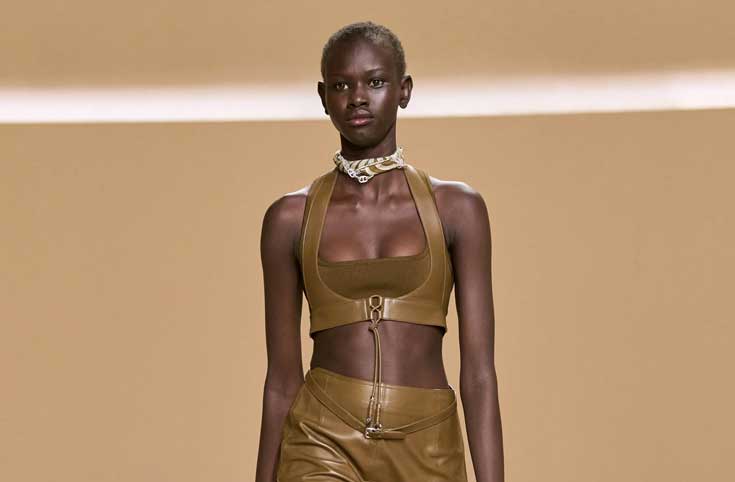HUSSEIN CHALAYAN ON THE CATWALK MOMENTS THAT DEFINED HIM

Hussein Chalayan has been invited by 10 to choose 10 catwalk moments that define him creatively. It’s not going to be an easy challenge for the designer. With almost three decades of fashion shows behind him, Chalayan was at the forefront of London’s Golden Age, from the mid ’90s through to the early ’00s, when he staged some of the most visceral fashion moments ever seen.
For the generation of young bloods at Central Saint Martins who graduated at the tail end of a biting recession, the energy and ambition in ’90s London was infectious. There was Britpop, Brit Art and Cool Britannia as New Labour swept to power in a landslide 1997 election. By that point, two opposing fashion forces had emerged: the savage beauty of Alexander McQueen and the cerebral minimalism of Hussein Chalayan. Their visions were poles apart but they shared the same conviction – that a fashion show should be a cultural experience that goes way beyond clothes.
“It was the nearest thing I had to being part of, not a movement exactly, but an energy,” recalls Chalayan. “There was this incredible synergy with the YBAs [Young British Artists]; we were all doing work that challenged social and sexual mainstreams. I met so many of them, Sarah Lucas, Wolfgang Tillmans. I worked with Björk and Michael Clark. Judy Blame styled our shows. Everything felt so fluid, so possible.”
It must have been around 8.45pm on September 1,1997, at the Atlantis Gallery in East London, when Chalayan first moved the fashion needle, at some point between the model whose head was encased in a wooden pod and the priestesses cloaked in white. Six figures walked into a blank white set wearing identical black chador cloaks, the proportions of which shrank in size until the final model walked out naked. They stood in a line, Muslim dress and nudity sharing the same stage, triggering shock and outrage. “The chadors are the moment I feel we had a collective awareness, some kind of cultural impact,” recalls Chalayan. “Maybe because it was an idea that wasn’t seen in fashion, it attracted a broader curiosity, especially from artists, and there was something quite visceral in that it seemed to be a criticism, but also a reframing of perspective.”
Was his aim to shock? “No, I didn’t know how it would be received. I just had this really big instinct to want to do it.” What would happen if he showed it today? “I would be in a lot of trouble.”
The show was called Between and in it Chalayan wanted to explore the notion of how we define our territory through dress codes and belief systems. “When you see a group of people dressed in this way it creates a boundary around them and I wanted to decipher that, so the pod heads eliminated identity and the mirrored head frames reflected those identities. It was also about being born as an empty tablet and, through cultural conditioning, acquiring another sense of existence. Also, the life and death situation, the nude as the new-born, the mummy-like state of the chadors…”
Come again? Even now I have trouble grasping his references. Imagine how new it was then – how baffling – to hear such abstract thinking backstage at a fashion show. Few had the time or energy to listen, let alone begin to absorb what he meant. Was he an artist? A visual poet? There was no category, shorthand or soundbite for what he did. He spoke artist, we spoke fashion.

PHOTOGRAPHY COURTESY OF MATTHEW STONE. RETOUCHING BY THE FORGE
I’ve been lucky enough to have a ringside seat from the beginning. We met in September 1993 on our first day at college, long before he buried his graduation collection in his friend’s garden or invented wearable paper ‘Airmail’ clothes you could send through the post.A Turkish Cypriot, he’d grown up between his mother in Nicosia and his father in London, via an unfortunate stint in a British boarding school aged eight. An original thinker, he could’ve studied fine art at Saint Martins. “But I thought fashion would be newer for me, I could bring together more alien worlds in the way I would approach it.” He knew he needed to find his own voice, as there were already so many amazing designers out there. “The Japanese greats, John Galliano, Margiela, Helmut Lang. I thought: what’s the point in doing what they already do so brilliantly? I knew this early on, that I wanted to create connections with other realms and maybe it would be harder for me, but I’d like to have a go.”
Chalayan, 53, is relentlessly inquisitive. He has a preoccupation with planes, flight paths, maps and border lines. His concerns are war, refugees and religion, and there’s his compulsion to research everything from ethnic identity to voodoo cursing. He will take an idea (never from fashion, unless historical) and deconstruct it from 360 degrees. Every collection is an opportunity for discovery and self-improvement. “The reason I do this is because there are so many things in the worldI don’t understand, and so I use my work to understand it. I refer to things outside of fashion so that my life is enriched. I do it, essentially, for myself.”
Many of his major moments have been powered by technology. We all remember his remote-control dresses that transformed at the touch of a button. Indeed, transformation is one of his favourite topics. His SS07 show One Hundred and Eleven saw six animatronic dresses rapidly morph through more than a century of silhouettes.“The most challenging collectionI’ve ever, ever worked on in my life. It’s the only time I broke into tears from stress while doing something.” Picture a high-necked Victorian gown of 1895 physically “growing” before our very eyes into a looser-fitting dress that rose to the calf à la 1910 before transforming into a distinctive 1920s flapper dress.Or the 1950s nipped waist full skirt that split into panels, elevated and flipped into a silver Paco Rabanne -esque 1960s number. “It was the most complicated, expensive, risky thing on earth with integrated technology woven into undergarments. So many things had to move sequentially so you could only show them once before re-programming them. It involved engineers, programmers, special cutting techniques, so much work and effort, I’d never done anything like it before. We took such big risks,” he says.
How risky? “I haven’t shared this with anyone before, but you remember the show with the sugar glass dress?” He’s referring to the finale of his SS01 Ventriloquy show where six models entered the stage, three of them with mallets which they used to smash their companions’ fragile skirts. “Well, she missed hitting the corner of the backstage door by two centimetres. When I saw that,I thought, my god, the whole idea would have collapsed, and I swore that was the last time I’m ever doing anything like this again.” He did do it again of course: “Because the excitement of me wanting to do something was always more powerful than the fear of it failing.”
What about the one catwalk moment that most defines him? Unequivocally, it is After Words, his AW00 show, otherwise known as the living room show, “because it’s probably my most well-known thing,” he concedes. Based on the plight of refugees and the horror of being displaced in times of war, the show is one of Chalayan’s most personal. “I used it as a way to talk about what happened to my family in Cyprus before the island was divided in 1974. My mother would have been around 14 years old when she had to leave her home and go into hiding.”
The stage at Sadler’s Wells theatre in North London was transformed into a minimal, white living room with four sitting room chairs, a table, a flatscreen television and an object-filled shelf. First, an average family walked on stage: mother, father, grandmother and children. Models appeared and began to seize the objects in the room, thrusting them into specially designed pockets to contain them. Another tableau of models then proceeded to remove the chairs’ upholstery and convert them into dresses that they put on. The chairs then magically folded up to become suitcases they carried away.
Most famously, the last model stepped into the centre of a circular wooden coffee table, pulled it up to her waist and hitched it to her belt, transforming it into a multi-slatted wooden skirt. She then walked off, leaving the room completely empty. In true Chalayan style, he tracked down a Bulgarian choir to accompany the show. “I remember them practicing with our producer Alex de Betak the night before when we were doing final fittings and their singing drifted through the courtyard of the studio. It was like prayers being chanted – that was a moment,” he says.

PHOTOGRAPHY COURTESY OF CHRIS MOORE
It is to Chalayan’s great credit that, beyond the catwalk wizardry, he also developed a powerful vocabulary of beautifully understated, elegant clothes. By 2001, when he started showing his collections in Paris, they became increasingly luxurious and sophisticated. Even if the most unlikely topics had inspired them, from malicious curses “eating away” the fabric to the 1974 film Murder on the Orient Express, the results were extraordinarily lovely. His favourite clothes of that era mixed Riviera-style broad-brimmed hats with bustiers and swishy palazzo pants. “One of my absolute bloody favourites,” he says of his SS10 show Dolce Far Niente, when he took to the stage as master of ceremonies and, microphone in hand, narrated his most glamorous collection to date wearing a tuxedo and a woven-in wig. “It was like my real hair. My mum didn’t want me to take that wig off for ages.”
It’s also worth remembering that Chalayan was one of the first fashion designers to be honoured with solo museum shows; once a rarity, they’re now a huge business – he led the way. Indeed, there are so many off-catwalk moments that have defined him. Like his first retrospective at the Groningen Museum in the Netherlands, or when he directed and designed the dance piece Gravity Fatigue at Sadler’s Wells, represented Turkey at the Venice Biennale with his art film Absent Presence, starring Tilda Swinton, and had other museum shows in Paris, London, Tokyo, Shanghai and Istanbul.
Chalayan has always transcended fashion. Is it any wonder he is being discovered by a new generation who hail him as a creative touchstone and torch-bearer? He has turned his art into business for 30 years. “What’s been exciting is that someone with my approach could’ve survived this long.” His art and fashion careers have always intersected. He must be one of the few designers who can sell a limited-edition art piece – be it a film or sculpture – alongside his incredible fashion experiences.
Now living and working nomadically between London, Istanbul, Athens and Berlin, where he holds a professorship at one of Germany’s largest universities of applied sciences, he continues to be propelled by his creativity. Whether he’s teaching his students, preparing for two new exhibitions coming up this year in Athens and Istanbul or collaborating with Kolon Sport, the Korean outerwear company, to make puffer coats, his values and integrity remain intact. “I have always thought that if you’re going to do this work you’ve got to take risks to create something new.”

PHOTOGRAPHY COURTESY OF CHRIS MOORE

1. BETWEEN, SS98
“The show with the chadors is the moment that I feel we had a collective awareness. It was such an important show for me, such a big risk. Other shows had excitement, but this had some kind of broader cultural impact. I remember doing it and then the actual after-effect hit in much later and went on and on. I love the aesthetic of that show, it was so pure.”
2. BEFORE MINUS NOW, SS00
“This was an interesting culmination of technology with something more poetic, lyrical and light. And it felt quite performative,” Chalayan says of the fibreglass remote control dress and another that expanded through memory wire.
3. AFTER WORDS, AW00
“I chose this because it’s probably my best-known thing. It was all about having to leave your home at a time of war and take all your possessions with you. I don’t think the audience had to know any of that – the transformation on stage made them feel something. The ‘moment’ for me isn’t the skirt, it’s when they started to strip off the chairs. My stomach was in my mouth: oh my God, are they doing it right? Is it going to work?”
4. VENTRILOQUY, AW01
“The smashing of the sugar-glass skirts symbolised destroying the alter ego to make a comment on the digital world – this was the year 2000, so I guess it was that question of where does reality begin and end? The big risk moment: the girl in the skirt just missed the edge of the backstage door. If that had smashed, the whole idea would have collapsed with it.”
5. MEDEA, SS02
“My first Paris show and I loved it. It was nerve-wracking because it was such a prestige issue for me to show there. It was about cursing, the relationship between actions and thoughts. I was trying to create a visual language through cursing and malice. I looked at layers of clothing, like layers of soil on an archaeological dig, as if the cursing had caused the layers of each garment to be taken away. In Cyprus when I was growing up there were a lot of superstitions to destroy people or make them change their minds.”

PHOTOGRAPHY COURTESY OF RUTH HOGBEN
7. ONE HUNDRED AND ELEVEN, SS07
“The most challenging collection I’ve ever, ever worked on. It was the most complicated thing on earth. Things could have just snapped. I think there was some external force that came into power and saved us that day.” The show pieces included six animatronic dresses, which were engineered to morph through over a century of fashion silhouettes.
8. AIRBORNE, AW07
“I wanted to talk about how weather cycles had parallels with the life/death cycles of the body. I’ve always been fascinated with the power of the weather, so I looked a lot at Japan and what the seasons mean there. There were two video dresses, using 15,600 LED lights combined with crystal displays. I loved the clothes [from that collection] inspired by samurai.”
9. DOLCE FAR NIENTE, SS10
Chalayan appeared as the master of ceremonies, wearing a slicked back, made-to-measure wig and tuxedo, narrating descriptions from the sidelines. “One of my absolute favourite collections, it was about how religious ideals of the past fused with Riviera style. I looked at Brigitte Bardot in Roger Vadim’s 1956 film And God Created Woman.”
10. PASATIEMPO, SS16
“I had been travelling in Cuba and I wanted to do something on the country opening up. It was about looking at how certain cultures evolve in isolation and how opening up to the West, a different culture, can then change behaviour. This is why, in the finale, the water that melts the dresses transforms the militant looks into quite provocative cocktail dresses.”
Taken from 10 Magazine Issue 72 UK – DARE TO DREAM – out now!

PHOTOGRAPHY COURTESY OF GETTY IMAGES/WWD











